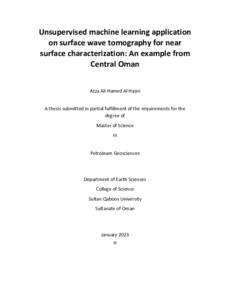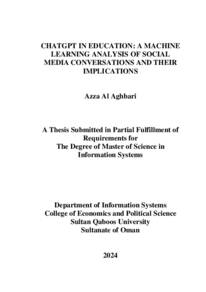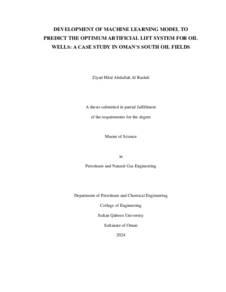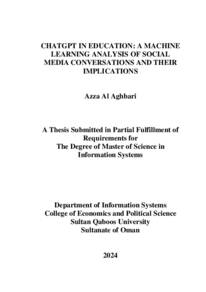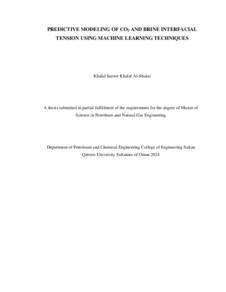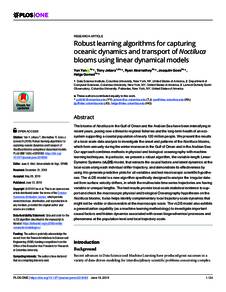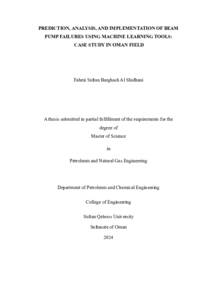Document
Unsupervised machine learning application on surface wave tomography for near surface characterization : an example from Central Oman.
Other titles
تطبيق التعلم الآلي غير الخاضع للإشراف بما يخص التصوير المقطعي بالموجات السطحية لوصف السطح القريب : مثال من وسط عمان
Publisher
Sultan Qaboos University.
Gregorian
2023
Language
English
English abstract
Many methods were developed to get a correct velocity estimate of the subsurface.
Erroneous velocities can cause incorrect positioning of reflectors, which thus affects
the imaging quality. Technology has been developed to have better velocity estimation.
From diving wave, and ray path tomography to full wave inversion. However, most
modeling techniques have shown limitations in constructing an accurate velocity for
the near-surface. Surface waves are used today in a wide range of near-surface
modeling. It has shown effectiveness in overcoming hidden layers and velocity
inversions within the near-surface. A large portion of the area within central Oman is
covered by dunes. The quality of the surface wave picking depends on seismic data
quality. The dune noise weakens the ground-roll energy. Furthermore, the fundamental
mode within dune areas is biased since several modes were mixed, which affects the
surface wave modeling process. Unsupervised machine learning was implemented to
segregate the dunes area from the non-dune to apply different preconditioning for
both areas. Then the areas were combined to build a guide function representing the
dispersion profile at each location to drive the surface-wave picking. The inverted
velocity using surface wave tomography shows a better correlation with topography
when machine learning is applied. As it was able to capture the velocity variations
within the area with a high resolution.
Member of
Resource URL
Arabic abstract
تم تطوير طرق مختلفة للتوصل إلى تقدير دقيق لسرعة الطبقات تحت سطح الأرض، حيث يمكن أن تتسبب الأسرعات الخاطئة للموجات الزلزالية في وضع العاكسات الموجية في غير مكانها الصحيح، مما يؤثر على جودة التصوير المقطعي. لذلك تم تطوير التكنولوجيا للحصول على تقدير أفضل لسرعة الموجات الزلزالية، بدءا من موجة الغوص، الى انعكاس الموجة الكاملة. وعلى الرغم من ذلك فقد أتضح أن معظم تقنيات بناء نموذج للسرعة محدودة في بناء سرعة دقيقة للسطح القريب من باطن الأرض. تستخدم الموجات السطحية اليوم في نطاق واسع في النمذجة القريبة من السطح. حيث أنها أظهرت فاعلية في التغلب على الطبقات المخفية وانقالبات السرعة القريبة من السطح. هناك مساحة واسعة في وسط عمان مغطاة بالكثبان الرملية، وتعتمد جودة تقدير الموجات السطحية على جودة البيانات للضوضاء خلال المسوحات الزلزالية في الصحاري وتعمل عائقا المواج ِّ مصدراً رئيساً الزلزالية. الكثبان الرملية الطاقة، كما يكون الوضع الأساسي داخل مناطق الكثبان الرملية متحيًزا حيث تم خلط عدة أوضاع، مما يؤثر على عملية نمذجة الموجة السطحية. تم تنفيذ تطبيق التعلم الألي غير الخاضع لللإشراف لفصل منطقة الكثبان الرملية عن المنطقة الخالية من الكثبان الرملية وذلك لتطبيق شروط مختلفة لكلتا المنطقتين. بعدها تم دمج المناطق للوصول الى دليل تشغيل تمثل ملف الأنتشار في كل موقع وذلك لاحتتساب الموجة السطحية. تُظهر السرعة المعكوسة باستخدام التصوير المقطعي للموجة السطحية ارتبا طا أفضل بالتضاريس عند تطبيق التعلم الآلي حيث أنه قادر على التقاط تغيرات السرعة داخل المنطقة بدقة عالية.
Category
Theses and Dissertations

